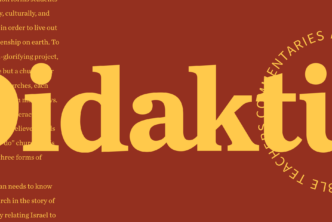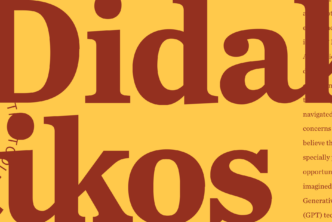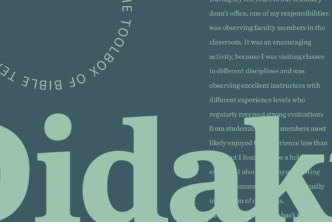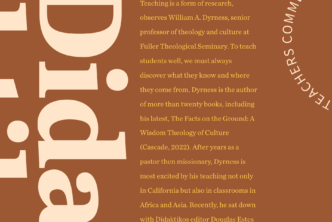
by Amy L. Balogh | University of Denver
As a professor who teaches Hebrew Bible and Judaic studies courses across Colorado’s Front Range while also working at the University of Denver’s Center for Judaic Studies, my non-Jewish identity is a topic of conversation more often than one might expect. These exchanges, as awkward as they are, also provide priceless opportunities to reflect on the pedagogical and ethical responsibilities that are specific to teaching and supporting a religious tradition other than the Christianity with which I was raised.
If there is one advantage to the commute from the University of Denver to Colorado College in Colorado Springs (the two places where I teach), it is the opportunity to reflect on the act and ethics of teaching. Here, I share four key challenges that my years of teaching Judaism have brought to light, as well as practical suggestions for how to meet those challenges. These subtle changes in my pedagogy have transformed my own classroom from a lecture-style data transmission to a thriving, critical engagement with whichever religious tradition I am teaching, whether ancient or modern.
1. Think seriously about the “Golden Rule.”
We all know the saying “do unto others as you would have them do unto you” (paraphrasing Matt 7:12; Luke 6:31) and may even use it as a prompt for reflecting on our own behavior from time to time, but how often do we pause and consider how we speak about others? As educators, our language has great power for good or ill. The way we speak about religious ideas and communities outside our own tradition often says more about our own theological or personal disposition than it does the “other,” yet language also is the means by which we model how our students are to think and speak about the tradition at hand, as well as how they are to treat the tradition’s adherents.
Imagine yourself in the position of an average person from the religious community whose tradition you are analyzing. What language appears in your classroom that you might find upsetting? Do you describe historical movements using evolutionary language, or do you use supersessionist or alienating terms, such as “primitive,” “old,” or “strange”? Would you like others to use those same terms to describe you or your faith? Often we are not aware of the effects of our own language until circumstances force us to perceive it from someone else’s perspective. The simple act of “doing unto others” has the power to change the trajectory of our classroom and lead us toward a pedagogy that promotes respect and empathy for all persons and communities.
2. De-center Christian modes of analysis and encourage your students to do the same.
To teach a non-Christian tradition on its own terms, the professor must de-center Christian theology, language, categories, topics, and narratives (such as heaven, hell, salvation, the trinity, grace, and so on) as the primary lenses through which we analyze and speak about all religions. Even students who are not Christian can exhibit such a mindset, as Christian ways of thinking and speaking about religion permeate the Western subconscious.
For example, it is inevitable in a course like Introduction to Judaism or even Introduction to Hebrew Bible that a well-meaning student will ask, “What do Jews think about [insert Christian theme here]?” In many cases, the honest truth is that Jews don’t think about that topic at all, because it simply isn’t part of Jewish tradition. What we can speak about are the myriad themes that are native to Jewish tradition and the ways Jewish thinkers and communities have expressed those themes throughout history. These themes are worthy of study in and of themselves, with or without any connection with Christian tradition.
3. Acknowledge and engage the plurality of views and experiences within a tradition.
In instances where one can answer the question “what do Jews think about x ?” the appropriate answer is often akin to “it depends on which Jew you ask”—meaning there is a wide variety of equally “Jewish” views on a given topic. One way to make this plurality plain to students is to trace a theme as you examine the tradition across space, time, and schools of thought.
For example, one theme that comes up immediately in Judaic studies (thanks to close readings of Genesis 1–3 and some of the Abrahamic stories) is women’s rights, a topic that students are attuned to already due to the current cultural climate. By keeping a pulse on what various thinkers and writers throughout the ages say (or don’t say) about women—from the biblical text to our conversations with Orthodox and Reform rabbis in the local community—students see for themselves that a wide variety of perspectives can exist side-by-side within a single tradition. This also underscores the point that Judaism values civil disagreement and argumentation in pursuit of understanding.
4. Your own religious identity or non-identity is a valuable tool toward critical thinking.
I used to avoid identifying myself as non-Jewish, squirming whenever I was asked the inevitable question, but I have since decided that self-identification is too valuable of a teaching moment to pass up. My self-identification as non-Jewish allows students to consider the difference perspective makes, and to look “behind the scenes” at an issue scholars in religious studies often face.
In hearing briefly about the emic/etic debate, students are encouraged to think through the advantages, disadvantages, and value of their own perspective, as well as the value of the diverse perspectives of their peers. This discussion becomes especially powerful when I draw students’ attention to the fact that they have not yet learned to analyze religion critically. In that respect, every student is at the same starting line, regardless of how much foundational knowledge (e.g., names, dates, definitions) they bring to their classroom experience.
As you consider and enact these suggestions, you may see transformation in more than just your pedagogy. All four of these suggestions, though simple in principle, require consistent self-monitoring and reflection, neither of which is an easy task.
One might even go so far as to describe these tasks as a small part of being “transformed by the renewal of your mind” (Rom 12:2 ESV), with the goal that both teacher and student will have a more ethical and empathetic orientation toward persons of faith beyond the bounds of Christianity.

This essay was first published in the July issue of Didaktikos: Journal of Theological Education (DidaktikosJournal.com).






